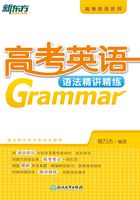
第三节 代词考点
代词是代替名词的一种词类。大多数代词具有名词和形容词的功能。英语中的代词,按其意义、特征及在句中的作用分为:人称代词、物主代词、指示代词、反身代词、相互代词、疑问代词、关系代词、连接代词和不定代词九种。代词如此庞杂,如何复习,并将其掌握好呢?研读历年高考试题我们可以发现,出现频率最高的是不定代词,其次是it用法、疑问代词、反身代词以及人称代词等。下面结合高考试题,对代词的易考点进行归纳总结。
一、考查不定代词的用法
1. 考查替代词one / ones,that / those的区别。
that用来代替前面提到过的单数名词或不可数名词,不能和冠词连用,其后总有修饰语,其复数形式是those。指代可数名词时,that相当于the one;those相当于the ones。one / ones用来代替前面提到过的可数名词,one替代单数,ones替代复数,所替代的是同名异物的名词,表示泛指,可有前置定语或后置定语,也可单独使用。特指时必须加定冠词the。
【考例】 In many ways, the education system in the US is not very different from_______in the UK.(2016浙江卷)
A. that
B. this
C. one
D. it
【答案】 A
【解析】 句意为:美国的教育体系与英国的教育体系在很多方面差异性不大。指代上文提到过的education system,并且后面有介词短语作定语,需填表示特指的that,故选A项。
【考例】 The quality of education in this small school is better than_______in some larger schools.(2015天津卷)
A. that
B. one
C. it
D. this
【答案】 A
【解析】 句意为:这所小型学校的教学质量要好于一些规模更大的学校。句中空格处代替前面的不可数名词The quality of education,故用代词that,表特指。代词it和one都可指代可数名词单数,但是it指代的是同名同物,one指代的是同名异物,表泛指。故选A项。
【考例】 To her joy, Della earned first the trust of her students and then_______of her colleagues.(2013辽宁卷)
A. that
B. one
C. ones
D. those
【答案】 A
【解析】 根据句意“让她高兴的是,德拉先赢得了学生的信任,然后又赢得了同事的信任”,此处不定代词用于替代不可数名词trust,应使用that。如果替代可数名词复数则用those或the ones。
【考例】 If you're buying today's paper from the stand, could you get_______for me?(2012辽宁卷)
A. one
B. such
C. this
D. that
【答案】 A
【解析】 句意为:如果你去报摊上买今天的报纸,给我捎回一份好吗?空格处表示泛指“一份报纸”,故用表示泛指单数名词的替代词one。that作替代词时通常表示特指,代替不可数名词或单数的可数名词。
【考例】 Studying Wendy's menu, I found that many of the items are similar to_______of McDonald's.(2012浙江卷)
A. those
B. one
C. any
D. all
【答案】 A
【解析】 句意为:通过研究温迪快餐店的菜单,我发现它的很多食品与麦当劳的相似。空格处替代前面出现的复数名词items,并且后面有后置定语of McDonald's,故用表示特指复数名词的替代词those。
2. 考查all, both, either, neither, each, none的用法。
both, either和neither皆表示两者,可作主语、宾语和定语。both还可作同位语。neither表示两者否定;either表示两者中任何一个,强调个体;both表示两者肯定。
all和none表示三者或三者以上。all表示全部肯定,而none表示全部否定。all可作主语、宾语、表语、定语和同位语;none作主语、宾语和同位语,但不能作定语。all作主语时,指人看作复数,指物看作单数;none作主语,看作单复数皆可。both, all, each, none作主语同位语时,通常放在行为动词前面,be动词、助动词和情态动词的后面。all和both与not连用表示部分否定。
【考例】 Mr. and Mrs. Zhang all work in our school.(2017全国卷Ⅱ,短文改错)
【答案】 all改为both,或删掉all
【解析】 因为主语是两个人,所以用both表示“两者都”,而all则表示三者或三者以上的“全部”。此处也可以去掉all。
【考例】 The research group produced two reports based on the survey, but_______contained any useful suggestions.(2015福建卷)
A. all
B. none
C. either
D. neither
【答案】 D
【解析】 句意为:这个研究小组基于调查做了两份报告,但是没有一份报告含有任何有用的建议。all与none指三者或三者以上,与前面的“two reports”不一致,可以排除A、B两项。neither意为“两者都不”,either意为“两者之一”。根据句意选择D项。
【考例】 —When shall I call, in the morning or afternoon?
—_______. I'll be in all day.(2014江西卷)
A. Any
B. None
C. Neither
D. Either
【答案】 D
【解析】 问句意为:“我什么时候打电话过来?上午还是下午?”根据答语“都可以,我一整天都在。”可知是在“上午”和“下午”这两种情况中做出选择,并且两种情况都可以。A、B项通常都表示三者或者三者以上的情况,neither表示两者都不。故D项正确,意思是“两者中的任意一个”。
【考例】 She'd lived in London and Manchester, but she liked_______and moved to Cambridge.(2014四川卷)
A. both
B. neither
C. none
D. either
【答案】 B
【解析】 句意为:她在伦敦和曼彻斯特都曾生活过,但这两个地方她都不喜欢,就搬到了剑桥。both表示两者都肯定;neither表示两者全部否定;none表示三者及以上全部否定;either表示两者中选择其一。此处是表示两者全部否定,故使用neither。
3. 考查other, the other, another, others的用法。
指代单数时,若是泛指,用another;若是特指,则用the other。
指代复数时,若是泛指,用other修饰名词的复数形式;若是特指,用the other修饰名词的复数形式。
others不能作定语,表示复数意义,相当于“other+复数名词”;the others相当于“the other+复数名词”。
another一般表示单数,其后接可数名词的单数形式。但若其后有数词或few修饰时,则可接复数名词。
【考例】 In some countries, people eat with chopsticks, while in_______, knives and forks.(2014福建卷)
A. another
B. others
C. both
D. all
【答案】 B
【解析】 句意为:在一些国家,人们用筷子吃饭。然而在另外一些国家,人们用刀和叉吃饭。others相当于other countries。Some...others...是固定搭配,意为“一些……,另一些……”。
【考例】 Neither side is prepared to talk to_______unless we can smooth things over between them.(2010全国卷Ⅱ)
A. others
B. the other
C. another
D. one other
【答案】 B
【解析】 neither含有“两者都不”之意,原文指双方都没准备好与对方交谈,故用the other指“两者中的另一个(方)”。
【考例】 The manager believes prices will not rise by more than_______four percent.(2008四川卷)
A. any other
B. the other
C. another
D. other
【答案】 C
【解析】 题干的意思应该是“价格增长不会再超过4%”;any other意为“其他的,另外的”;the other意为“两者中第二者”;another意为“另外,又”,可放在数词前面;other表示“另外”时,和more一样,要放在数字的后面。
4. 考查some, any及其相应复合代词的辨析。
some多用于肯定句,any多用于否定句、疑问句。但下列情况中常用some:
1)some后接单数可数名词,意为“某一”时,相当于“a certain+单数可数名词”。
2)在表示请求或邀请的句子中,为了期望对方给予一个肯定的答复,通常用some,而不用any。
在下列肯定句中常用any:
1)用于陈述句或祈使句中,作代词或形容词,意为“任何,无论哪一个”,后接可数名词单数形式。如:
Any book will do —I just want something to read on the train.
2)用于肯定的条件句中,用作代词或形容词,意为“什么,一个(些)”;if any意为“若有的话”。如:
He asked me if I had any books in my desk.
Correct the mistakes in his composition, if any.
some, any, every常与-one, -body, -thing构成复合不定代词,其基本用法与some, any, every用法相当。
【考例】 The meeting will be held in September, but_______knows the date for sure.(2015重庆卷)
A. everybody
B. nobody
C. anybody
D. somebody
【答案】 B
【解析】 句意为:会议将在九月举行,但没有人知道确切的日期。根据but表示转折可知要填nobody,意为“没有人知道”,故选B项。
【考例】 You can ask anyone for help._______here is willing to lend you a hand.(2014安徽卷)
A. One
B. No one
C. Everyone
D. Someone
【答案】 C
【解析】 句意为:你可以向任何人求助。这里的每一个人都愿意向你伸出援助之手。强调“所有人”用everyone。
【考例】 A smile costs_______, but gives much.(2014重庆卷)
A. anything
B. something
C. nothing
D. everything
【答案】 C
【解析】 句意为:微笑不需要我们花费任何东西,但是却会给我们很多。anything意为“任何东西”;something意为“某些东西;重要人物”;nothing意为“什么也没有”;everything意为“所有的东西”。本题中的关键词是but,说明上下文之间是转折关系,所选词要和后面的much表示相反的意思,故C项正确。
【考例】 —Have you figured out how much the trip will cost?
—$ 4,000, or_______like that.(2012福建卷)
A. anything
B. everything
C. something
D. nothing
【答案】 C
【解析】 句意为:——你算出旅行要花多少费用了吗?——4000美元,或大致如此。something like that意为“大致如此,差不多这样”,something在本句中表示不确定的描述或数量,意为“大致,左右”。
二、考查it的用法
1. 考查it替代上文提到的事物或情况。
【考例】 However, the railway quickly proved to be a great success and within six months, more than 25,000 people were using 67 every day.(2017全国卷Ⅱ)
【答案】 it
【解析】 空格处缺少的词是谓语were using的宾语,结合句意可知该词指的是上文提到的the railway,为避免重复,应填入代词it指代the railway。
【考例】 An average of just 18.75cm of rain fell last year, making_______the driest year since California became a state in 1850.(2014浙江卷)
A. each
B. it
C. this
D. one
【答案】 B
【解析】 句意为:去年一年加利福尼亚平均降雨量仅为18.75厘米,是它自1850年成为州以来最干旱的一年。此处要用代词it指代前面的名词last year。
2. 考查it作形式主语或宾语,代替不定式、动名词、主语从句或宾语从句。
【考例】 Susan made_______clear to me that she wished to make a new life for herself.(2014山东卷)
A. that
B. this
C. it
D. her
【答案】 C
【解析】 句意为:苏珊让我了解了她希望开始新生活的想法。主句部分为主谓宾补结构。that引导的是宾语从句。宾补前面缺的是形式宾语,因此选择it作为形式宾语。
【考例】 No matter where he is, he makes_______a rule to go for a walk before breakfast.(2012陕西卷)
A. him
B. this
C. that
D. it
【答案】 D
【解析】 句意为:无论他在哪里,他都有早饭前散步的习惯。空格处所填单词做动词make的形式宾语,真正的宾语是不定式短语to go for a walk before breakfast。
3. 考查it用于构成强调结构。
强调结构的基本形式是It is / was+被强调部分+that / who...,可以用来强调主语、宾语、状语等,不能强调谓语动词,此结构去掉后句子依然成立。注意强调结构的疑问句式、not...until...强调句式等变形。通常考查强调结构的判别以及使用强调结构后的主谓一致。
【考例】 It was 80 years before Christopher Columbus crossed the Atlantic_______Zheng He sailed to East Africa.(2012重庆卷)
A. when
B. that
C. after
D. since
【答案】 B
【解析】 此题考查特殊句式之强调句。句意为:早在克里斯托弗·哥伦布穿越大西洋的80年前,郑和就航行到了东非。本句特意强调时间状语,强调郑和远航东非的了不起。去掉It was...that...后,句子依然成立,故此句是一个强调句,空格处应填that。
三、考查疑问代词、反身代词以及人称代词等的用法
【考例】 If our parents do everything for us children, we won't learn to depend on_______.(2010上海卷)
A. themselves
B. them
C. us
D. ourselves
【答案】 D
【解析】 主语为we,因此应填反身代词ourselves。depend on oneself意思是“依靠自己,自力更生”。
【考例】 Our neighbors gave_______a baby bird yesterday that hurt_______when it fell from its nest.(2008湖南卷)
A. us; it
B. us; itself
C. ourselves; itself
D. ourselves; it
【答案】 B
【解析】 第一空用人称代词us,动作的发出者和承受者不同;第二空用反身代词,指前面幼鸟本身。
【考例】 Isn't it amazing how the human body heals_______after an injury?(2008江西卷)
A. himself
B. him
C. itself
D. it
【答案】 C
【解析】 itself 指代前面的the human body。
【考例】 My daughter often makes a schedule to get_______reminded of what she is to do in the day.
A. herself
B. her
C. she
D. hers
【答案】 A
【解析】 根据句意“我女儿经常制定时间表来提醒自己一天中应该做什么”可知应使用反身代词。
【考例】 The mother didn't know_______to blame for the broken glass as it happened while she was out.
A. who
B. when
C. how
D. what
【答案】 A
【解析】 根据句意“妈妈不知道这个杯子碎了该怨谁,因为事情发生在她出去的时候”可知应选用疑问代词who。
【考例】 —Susan, go and join your sister cleaning the yard.
—Why_______? John is sitting there doing nothing.
A. him
B. he
C. I
D. me
【答案】 D
【解析】 本题考查人称代词在口语中的使用情况。“why+动词原形或代词”表示“责备”或“抱怨”的意思。根据对话的意思,可以排除A、B两个答案。口语中why后常用宾格。